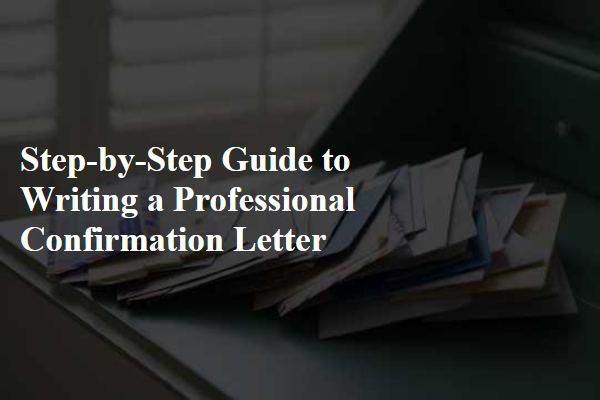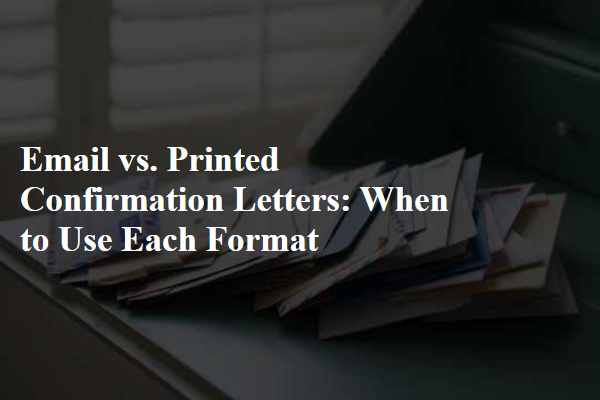
Begin by clearly stating the purpose of the letter, confirming specific details such as dates, agreements, or attendance. Use concise and formal language to maintain professionalism, and include all relevant information to avoid misunderstandings. End the letter with a polite closing, offering contact information for any further clarification.
Understanding the Purpose of a Confirmation Letter
Writing a professional confirmation letter requires clarity and precision to ensure all parties understand the agreed terms. This guide provides a structured approach to crafting an effective confirmation letter.
Follow these essential steps to create a clear and professional confirmation letter.
- Start with a clear subject line - Summarize the purpose of the letter to immediately inform the recipient.
- Include essential details - Specify dates, names, and agreements to confirm the key points accurately.
- Maintain a formal tone - Use polite and professional language to uphold the letter's credibility.
Gathering Essential Information
What is a professional confirmation letter? A professional confirmation letter is a formal document used to verify agreements, appointments, or important details between parties. It serves as written proof to avoid misunderstandings.
How should you begin writing a confirmation letter? Start with a clear and concise opening statement that specifies the purpose of the letter. Include relevant details such as dates, names, and agreements to establish context.
What tone is appropriate for a confirmation letter? Use a polite and professional tone throughout the letter to ensure clarity and respect. Avoid casual language to maintain formality and credibility.
Which key components must be included? Essential elements include a subject line, date, recipient's name, a concise confirmation statement, and a closing with contact information. These ensure the letter is complete and easy to reference.
How do you verify details before sending? Double-check all facts such as names, dates, and specific terms to prevent errors. Accuracy strengthens the letter's reliability and professional appearance.
What format should you use when writing the letter? Use a standard business letter format with aligned margins, professional font, and clear headings. Proper formatting enhances readability and presentation.
When is it appropriate to send the confirmation letter? Send the letter promptly after an agreement or appointment is confirmed to provide timely documentation. Early communication reduces confusion and confirms mutual understanding.
How can you close a professional confirmation letter effectively? End with a courteous closing phrase and include your signature or typed name. Offer additional contact information if further communication is needed.
Why is preserving a copy important? Keeping a copy of the confirmation letter helps maintain records for future reference or dispute resolution. It acts as evidence of agreement and professional communication.
Choosing the Appropriate Format
Writing a professional confirmation letter requires clarity and precision to ensure all important details are communicated effectively. This type of letter serves as official verification of agreements, appointments, or transactions.
A step-by-step guide begins with addressing the recipient correctly and stating the purpose of the letter upfront. Include specific details such as dates, times, and referenced documents to avoid misunderstandings. Conclude with a polite closing that invites further communication if needed.
Writing a Clear Subject Line
| Step | Description |
|---|---|
| 1. Use a professional header | Include your name, address, phone number, and email at the top. Add the date and the recipient's contact details to ensure clarity. |
| 2. Begin with a formal greeting | Address the recipient by their proper title and full name to maintain professionalism. |
| 3. State the purpose clearly | Open the letter by clearly stating the intention to confirm an agreement, appointment, or other relevant matter. |
| 4. Provide detailed information | Include important details such as dates, times, locations, or terms related to the confirmation to avoid misunderstandings. |
| 5. Express appreciation or positive regard | Conclude with a polite sentence expressing gratitude, anticipation, or professionalism. |
| 6. Use a formal closing | End with a professional sign-off such as "Sincerely" or "Best regards," followed by your full name and title. |
| 7. Proofread the letter | Check for spelling, grammar, and accuracy of facts before sending the confirmation letter to ensure quality. |
Addressing the Recipient Properly
Writing a professional confirmation letter ensures clarity and trust in business communications. It serves as official documentation for agreements, appointments, or transactions.
Start by clearly stating the purpose of the letter in the opening paragraph. Include essential details such as dates, names, and reference numbers to avoid misunderstandings.
Maintain a formal tone throughout the letter, using concise and direct language. Verify all information for accuracy before finalizing the document.
End with a polite closing statement, inviting further communication if necessary. Sign the letter with your full name, title, and contact information to validate authenticity.
Stating the Confirmation Clearly
Writing a professional confirmation letter ensures clarity and mutual understanding between parties. This guide provides essential steps to create an effective and formal confirmation letter.
- Identify the purpose - Clearly state the reason for the confirmation to avoid misunderstandings.
- Include detailed information - Add relevant dates, names, and terms to provide complete context.
- Use a formal tone - Maintain professionalism to uphold credibility and respect.
Follow these steps to draft a concise and authoritative confirmation letter that meets professional standards.
Including All Relevant Details
Writing a professional confirmation letter requires clarity and precision to ensure all important details are communicated effectively. This letter serves as a formal acknowledgment of an agreement, appointment, or transaction.
Begin the letter with the date, recipient's name, and contact information to maintain a formal structure. Clearly state the purpose of the confirmation early in the letter to avoid confusion.
Include specific details such as dates, times, locations, or terms relevant to the confirmation. Use polite and straightforward language to reinforce professionalism.
Conclude with a courteous closing statement expressing readiness to assist further if needed. Sign off with your full name, title, and contact details to provide credibility and facilitate follow-up.
Using Professional Language and Tone
Writing a professional confirmation letter requires clarity and precision to ensure all parties understand the agreement or information confirmed. This guide provides a structured approach to crafting an effective and formal confirmation letter.
- Start with a clear heading - Include the date, recipient's name, and subject line to identify the purpose immediately.
- State the purpose upfront - Begin the letter by clearly stating what is being confirmed to avoid any confusion.
- Include detailed information - Provide specific details such as dates, names, and key terms relevant to the confirmation.
- Use a professional tone - Maintain formal and polite language throughout the letter to reflect professionalism.
- End with a call to action - Encourage the recipient to acknowledge receipt or contact you for further clarification.
- Close with a formal signature - Sign off politely with your name, title, and contact information for authenticity.
Reviewing and Editing the Letter
Writing a professional confirmation letter requires clear and concise communication to validate important information. Begin by stating the purpose of the letter and referencing the specific details being confirmed, such as dates, agreements, or appointments. Conclude with a polite closing that invites further contact if necessary.
Finalizing and Sending the Confirmation Letter
Writing a professional confirmation letter involves clearly stating the purpose, confirming specific details, and providing contact information for further communication. Begin with a formal greeting and reference the subject or event being confirmed. Use concise language to ensure clarity and end with a polite closing and signature.



Comments